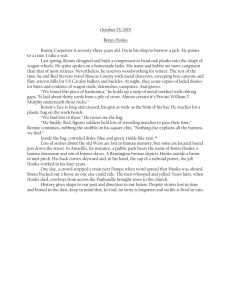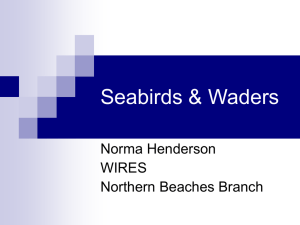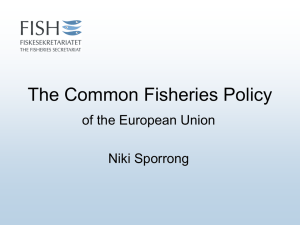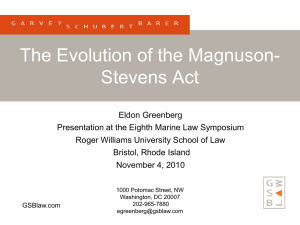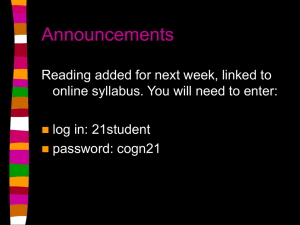Marine Turtle By-catch Reduction in Long-line Fisheries - Eco
advertisement
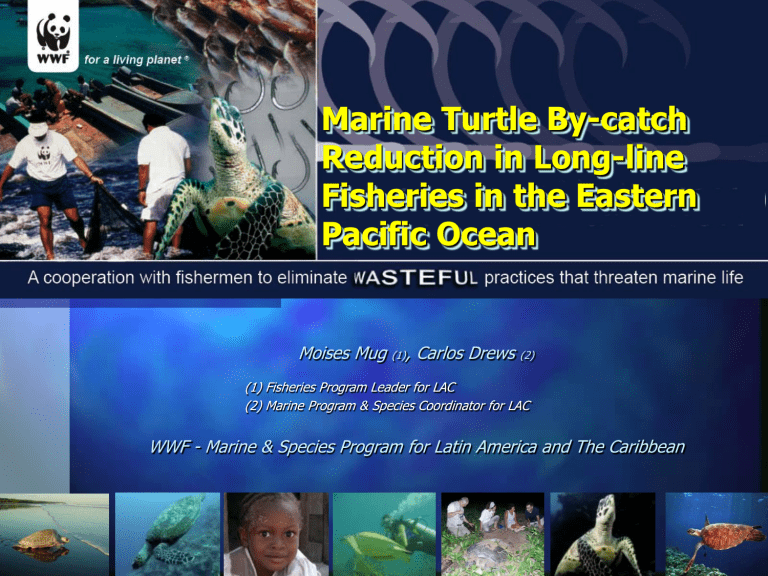
Marine Turtle By-catch Reduction in Long-line Fisheries in the Eastern Pacific Ocean Moises Mug (1) , Carlos Drews (2) (1) Fisheries Program Leader for LAC (2) Marine Program & Species Coordinator for LAC WWF - Marine & Species Program for Latin America and The Caribbean Global fish crisis 48% of fish stocks in South American Pacific waters are overexploited (FAO) Mahi-mahi Yellow-fin tuna WWF Carlos Drews When marine turtles meet fisheries … Marine Turtles Fisheries LAC Fisheries Program Leader Moisés Mug Bycatch 250.000 loggerheads and 50.000 leatherbacks caught yearly in longlines globally. Sandra Andraka Senior Bycatch Officer Critically endangered leatherbacks - a bycatch mitigation response Working principles (after Martin Hall) No one wants to catch turtles No one wants to put fishermen out of business Data courtesy of Rotney Piedra MINAE 98% decline in 20 years! Up to 70 miles long - 8,000 hooks Longline fisheries J- hooks Circle hooks Large circle hooks reduce marine turtle catch rates by over 60% (NOAA/NMFS in the Atlantic). Pacific Longlines: Tuna, Mahi Mahi, Swordfish…. and turtles! . Outcomes: Turtles and fisherman together leading transformation! New gear • Transform 20% of1.Eastern Pacific fleet to better fishing gear 2. Fishermanturtle take the lead • Save the Pacific leatherback 3. Governments • Set a ground-breaking precedentand in amarkets powerful tuna fishery management body (IATTC) • Stimulate fisherman lead reform across 11 Pacific countries © Michael Patrick O´Neill The largest, field based, fisheries conservation project in the history of marine conservation • Region-wide collaborative work (8 countries) • A team led by WWF and IATTC: Industry, artisanal sector, exporters, fisheries authorities, NGOs from • Mexico • Guatemala • El Salvador • Costa Rica • Panama • Colombia • Ecuador • Peru • Partners: WWF, IATTC, NOAA, USAID, US State Department, WCPFC, Japan, Ocean Conservancy, Mustad, Packard, Royal Caribbean, OSPESCA, … SOLUTION: Large Circle hooks and BestFishing Practices Source: IATTC TECHNOLOGY: substitute J hooks with large C hooks across Pacific fisheries BEST FISHING PRACTICES - Marine stewardship: rescue & release techniques for turtles VOLUNTARY ADOPTION: hook exchange Time/area management: next steps OUR CHALLENGE in the Eastern Pacific Ocean Altar 11 (Ecuador) 1,229 industrial fishing vessels in the EPO (10% EPO coastal countries) (larger than 24 m long, mean size is 45.5 m). Fishing trip duration 4-6 months. Chen Chieh 21 (Taiwan) More than 3,800 fishing vessels, including artisanal smaller than 24 m. Plus thousands of outboard motor boats that 211 Donwon (Korea) fish with long-lines (16,000 only in Ecuador). Fishing trip duration 5 to 30 days. Fong Kuo 6 (Vanuatu) IATTC covers industrial long-line fisheries. Artisanal long-line fleet in LAC is an opportunity. Our goal: 2,000 vessels in 3 years … the tipping point. Don Jorge (Costa Rica) Artisanal fleet - Manta, Ecuador Almost 4 years of work (2004-2007) > 80,000 J hooks replaced > 1,000 experimental fishing trips in all countries. • No fisherman has ever returned to using J-hooks > 3,800 fishermen and 138 onboard observers trained • Central American fishers forming sustainable fisheries foundation > 300 captains and their fishing vessels in the program • Programme acknowledged as excellent model > 86 vessels completely transformed. • Wal-Mart Central America prepared to preferentially source fish caught on circle hooks Working relationships with NOAA and Mustad (200,000 hooks donated). Hook performance on turtle bycatch Turtles caught per 1000 hooks 3.5 Changes in hooking location Mahi-mahi fishery 3 % (“bad hookings”) 2.5 J hooks 2 1.5 - 60% 1 J Hooks C Hooks 53% C14 - 27% 15% C15 14% 15% 0.5 Hall et al. Crete 2006 0 Tuna fishery Mahi-mahi fishery Hook performance on target species Fish caught per 1000 hooks 60 50 J Hooks C Hooks 40 - 20% 30 + 22% 20 10 0 Tuna fishery Mahi-mahi fishery First voluntary, multi-national observers program with artisanal fishermen in the world The greatest assett TRUST Bycatch mitigation Selective gear Best practices Competitive markets Data collection, monitoring & evaluation On-board observer program Capacity Access rights Sustainable fisheries Management
